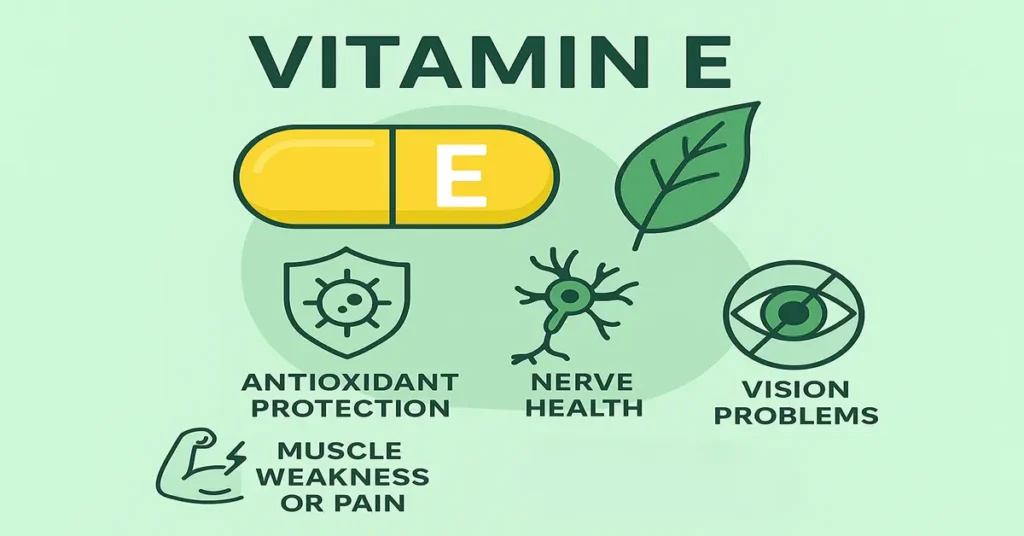What is the Vitamin E Test?
The Vitamin E test measures the level of Vitamin E (mainly alpha-tocopherol) in your blood.
Vitamin E is a fat-soluble antioxidant vitamin that helps protect your body’s cells from oxidative damage caused by harmful molecules known as free radicals.
This test is useful for identifying:
- Vitamin E deficiency (common in people with poor nutrition or absorption problems)
- Excess levels (caused by overuse of supplements)
- Monitoring nutritional therapy in patients with malnutrition, liver problems, or fat-absorption disorders
Doctors often order this test when there are symptoms of nerve problems, muscle weakness, or poor fat absorption.
Where is Vitamin E Produced in the Body?
Unlike some vitamins, Vitamin E is not synthesized by the human body — it must come from external sources.
Sources of Vitamin E:
- Dietary sources
– Nuts (almonds, hazelnuts)
– Seeds (sunflower, pumpkin)
– Vegetable oils (sunflower, wheat germ, safflower oil)
– Green leafy vegetables
– Fortified cereals and foods - Supplements
– Vitamin E capsules or multivitamins (when prescribed)
After absorption in the intestine (along with dietary fats), Vitamin E is stored in the liver and fatty tissues.
It is then transported through the blood by lipoproteins (fat-carrying proteins), ensuring a steady supply to all body cells.
Main Functions and Importance of Vitamin E
Vitamin E plays a major role in protecting body tissues and supporting several vital functions.
- Antioxidant protection:
Shields cells from oxidative damage and free radicals - Immune support:
Strengthens immunity, particularly in elderly individuals - Healthy skin and eyes:
Maintains skin elasticity and protects the retina - Blood circulation:
Prevents clot formation by keeping blood vessels wide and flexible - Nerve and muscle protection:
Vital for proper functioning and structure of nerve cells and muscles
In short, Vitamin E acts like your body’s natural defense system against oxidative stress and cell damage.
Causes of Low Vitamin E (Deficiency)
Deficiency is rare in healthy individuals but can occur due to certain health issues or poor diet.
Common causes include:
- Poor dietary intake (especially in infants or malnourished adults)
- Fat-absorption problems, such as:
- Cystic fibrosis
- Celiac disease
- Chronic pancreatitis
- Liver or bile-duct disorders
- Genetic disorders affecting Vitamin E transport (e.g., abetalipoproteinemia)
- Premature birth, where babies have low Vitamin E stores
Symptoms of Low Vitamin E
Low Vitamin E affects nerves, muscles, and immunity.
Symptoms may include:
- Muscle weakness or pain
- Numbness, tingling, or nerve pain
- Vision problems (blurred vision, retinal damage)
- Poor coordination and balance (ataxia)
- Weak immunity (frequent illness or infection)
- In infants: Irritability, swelling, or hemolytic anemia (red blood cell breakdown)
If untreated, severe deficiency may cause long-term nerve damage or muscle degeneration.
Causes of High Vitamin E (Toxicity)
Excess Vitamin E levels are uncommon and almost always caused by supplements, not food.
Main causes:
- Taking too many Vitamin E supplements
- Overuse of fortified foods and supplements together
- Food alone almost never leads to toxicity
Symptoms of High Vitamin E Levels
Too much Vitamin E can interfere with blood clotting and cause several issues:
- Nausea or diarrhea
- Headache, tiredness, or dizziness
- Blurred vision
- Increased bleeding risk (Vitamin E can thin the blood)
- Serious risk if combined with blood-thinning medicines like warfarin
Reference Ranges (Normal Values)
(May vary slightly between laboratories)
| Measurement | Normal Range | Unit |
|---|---|---|
| Adults | 5.5 – 17 | mg/L |
| Adults | 12 – 40 | µmol/L |
In some cases, doctors interpret Vitamin E levels along with lipid (fat) levels because Vitamin E travels in the bloodstream attached to fats.
Sample Type and Test Details
Sample Type: Serum (blood sample)
Tube Used: Red-top (plain) tube
Fasting: Usually not required, unless combined with other tests
Test Method: Performed using high-performance liquid chromatography (HPLC) or immunoassay
How to Maintain Healthy Vitamin E Levels
- Eat a balanced diet rich in nuts, seeds, and vegetable oils
- Include leafy greens and fortified foods in daily meals
- Avoid excessive supplements unless prescribed
- Monitor Vitamin E levels if you have liver, pancreas, or intestinal problems
- Avoid smoking, which reduces antioxidant levels in the body
Health Conditions Related to Vitamin E Deficiency
Chronic low Vitamin E can increase the risk of:
- Nerve damage (neuropathy)
- Muscle degeneration
- Vision loss (retinopathy)
- Immunity problems
- Premature aging and oxidative stress
- Heart and circulation disorders (due to low antioxidant protection)
When Should You Get a Vitamin E Test?
A doctor may recommend this test if you have:
- Symptoms of nerve weakness, numbness, or poor balance
- Muscle pain or weakness without other explanation
- Signs of malabsorption (weight loss, diarrhea, fatty stools)
- Liver, gallbladder, or pancreatic diseases
- You take Vitamin E supplements regularly
Test Preparation
- No fasting needed (unless instructed)
- Inform your doctor about all supplements or medicines (especially blood thinners)
- Avoid taking Vitamin E supplements 24–48 hours before the test if possible
- Drink water normally before giving a blood sample
When to Consult a Doctor
See your doctor if:
- You experience muscle weakness, balance problems, or vision issues
- You take high-dose supplements without medical advice
- You have fat-absorption disorders or liver disease
- Your Vitamin E level is below 5 mg/L or above 17 mg/L
A healthcare provider may recommend dietary changes, supplement adjustment, or additional tests (like lipid profile or Vitamin A/D tests) to evaluate your nutritional status.
Important Word Explanations
| Term | Meaning |
|---|---|
| Antioxidant | A substance that protects cells from free radical damage |
| Fat-soluble | Stored in body fat and used slowly over time |
| Ataxia | Loss of muscle coordination or balance |
| Hemolytic anemia | Breakdown of red blood cells |
| µmol/L | Micromoles per liter – lab measurement unit |
| Serum | Clear part of blood used for chemical testing |
~END~

